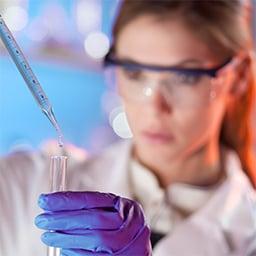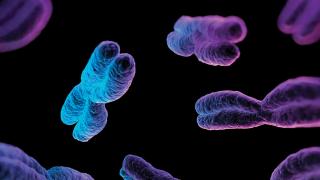
At the beginning of December, during the all-virtual ASH 62nd Annual Meeting and Exposition, experts at City of Hope presented pivotal research and clinical trial findings related to hematopoietic cell transplantation (HCT) advances as well as novel immunotherapy and treatment approaches for cancers that are some of the most difficult to treat.
Reducing GvHD risk and improving survival outcomes for HLA-mismatched unrelated stem cell transplant patients
Over the years, HCT research at City of Hope has led to numerous advances that have made transplants safer and available to more patients than ever before. Encouraging clinical trial demonstrated efficacy of post-transplant cyclophosphamide (PTCy) as a graft-versus-host-disease (GvHD) prophylaxis in mismatched unrelated donor (MMUD) HCT was presented by Monzr M. Al Malki, M.D., director of the Unrelated Donor Bone Marrow Transplant Program and the Haploidentical Transplant Program at City of Hope.
Finding a histocompatible (HLA) matched relative for patients in need of a transplant occurs only 30% of the time leaving roughly 70% of patients in search of an unrelated HLA-compatible matched donor. For underrepresented minorities, there is less than 10% chance to find this type of match which is why breakthroughs in haploidentical transplant and MMUD have been lifesaving. Although access has been expanded, a drawback to MMUD HCT is the increased risk of GvHD and subsequent effect on survival outcomes even when conventional calcineurin inhibitor-based prophylaxis is used.
Armed with established efficacy data about the use of PTCy as part of post-haploidentical HCT GvHD, the team began investigating the previously unexplored efficacy of PTCy as a GvHD prophylaxis after peripheral blood stem cell MMUD HCT and the GvHD-free relapse and progression free-survival (GRFS) at one-year post HCT.
38 patients, all less than 75 years of age, were scheduled for HCT and received myeloablative conditioning or reduced intensity conditioning. All patients also received GvHD prophylaxis of PTCy (50 mg/kg x 2 days), tacrolimus (1 mg/d), and MMF (1g x 3/d). The PTCy prophylaxis showed positive results with one-year overall survival and GRFS of 87% (95% CI: 71-94) and 68% (95% CI: 51-81), respectively. These findings present new possibilities for MMUD HCT patients with hematologic disorders.
Post-HCT immunotherapy consolidation leads to favorable progression-free survival outcomes in patients with high-risk Hodgkin lymphoma
Current standard of care treatment for patients with relapsed or refractory (RR) Hodgkin lymphoma (HL) involves salvage therapy followed by autologous HCT (autoHCT); however, many high-risk RR HL patients relapse or progress after autoHCT. As a result, there is a dire need for a treatment approach with greater efficacy. Recent findings from a multi-center phase 2 post-HCT consolidation study of two immunotherapy drugs led by Alex F. Herrera, M.D., assistant professor, Department of Hematology & Hematopoietic Cell Transplantation, may lead to the current standard of care being redefined.
A number of separate studies have demonstrated that post-HCT consolidation with individual immunotherapy drugs like brentuximab vedotin (BV) or nivolumab have resulted in improved progression-free survival (PFS) in high-risk RR HL patients, and combinations of the two drugs are a safe and effective salvage treatment for HL. City of Hope built upon that knowledge by evaluating the safety and efficacy of a combination nivolumab/BV post-HCT consolidation in 59 high-risk RR HL patients.
Post-HCT, patients received a median of 8 cycles of nivolumab/BV, and the 18-month PFS and overall survival in all patients were 92% and 98%, respectively. These results indicate that the immunotherapy combination is a promising treatment approach.
Greater survival outcomes illustrate the viability of HCT for treatment of older patients with myelodysplastic syndrome
Encouraging results from a trial conducted by Ryotaro Nakamura, M.D., director of the Center for Stem Cell Transplantation, comparing reduced intensity allogeneic hematopoietic cell transplantation (HCT) to hypomethylating therapy or the best supportive care in older patients with advanced myelodysplastic syndrome (MDS), may cause hematologists and oncologists to rethink their current treatment approach for this patient group.
While a number of treatment options are available for MDS, only allogeneic HCT currently exists as a curative therapy. However, HCT is associated with significant risks of complications. Early transplantation is infrequently offered to older MDS patients because of a lack of data defining benefits of HCT compared with non-HCT therapy.
The multicenter, biologic assignment trial enrolled 384 patients between the ages of 50-75 with higher risk de novo MDS who were also eligible for reduced-intensity conditioning allogeneic HCT into Donor (n=260) or No Donor arm (n=124) groups. Patients in the No Donor arm group received non-HCT therapy according to institutional standards.
An intent-to-treat analysis showed overall survival (OS) to be 47.9% (95% CI: 41.3-54.1) in the Donor arm compared to 26.6% (95% CI: 18.4-35.6) in the No Donor arm, 3-years after the study enrollment. Leukemia-free survival at 3-years was also greater (35%; 95% CI: 29.8-41.8) in the Donor arm compared to the No Donor arm (20.6%; 95% CI: 13.3-29.1). The quality of life (QOL) measures were not different between the two arms, indicating that the survival advantage with HCT was not associated with detriment of QOL. The team concluded that HCT should be included as an integral part of MDS management plans in fit older adults with higher risk MDS, and early referral to a transplant center is strongly recommended.
The trial is part of Blood and Marrow Transplant Clinical Trials Network, which was established with support from the National Heart, Lung and Blood Institute and National Cancer Institute, because of a critical need for multi-institutional clinical trials focused directly on improving survival for patients undergoing HCT.
Novel Post-transplant prophylaxis conditioning regimen reduces risk of GvHD and relapse in patients with acute myeloid leukemia
While allogeneic HCT provides patients with acute myeloid leukemia (AML) with intermediate or high-risk cytogenetics the highest curative rate, it is not without risks. A long-term burden of morbidity, of which GvHD is the main cause, exists for patients even though numerous advances in pre- and post-transplant prophylaxis and conditioning therapy have been made. In order to reduce the risk of GvHD and the risk of relapse Anthony S. Stein, M.D., associate director of the Gehr Family Center for Leukemia Research developed and evaluated a novel post-transplant conditioning method in a pilot study.
The conditioning method, which consisted of total marrow and lymphoid irradiation (TMLI) and post-transplant cyclophosphamide (PTCy), was designed with an attempt to reduce risk of relapse associated with PTCy by using escalating doses of TMLI as well as the risk of chronic GvHD.
A total of 18 patients between the ages of 18-60 were enrolled and treated with TMLI, without the addition of chemotherapy, at a dose of 2000 cGy (the dose delivered to the liver and brain was 1200 cGy) delivered in 200 cGy fractions twice daily. After receiving peripheral blood stem cells, PTCy was given at a dose of 50 mg/kg for GvHD prevention alongside tacrolimus.
At 1-year, the GvHD-free/relapse-free survival (GRFS) was 60% (95% CI: 28.8-80.3). Estimates of OS and relapse-free survival at 1-year were 100% and 80.8% (95% CI: 50.5-93.6), respectively. In addition to having all patients achieve engraftment, nonrelapse mortalities were zero percent at one year with this conditioning regimen and preliminary results suggest an improved GRFS rate than previously established. Participants with more than 1-year of follow-up were also able to discontinue immunosuppressive therapy, reducing one of the financial burdens associated with allogeneic HCT.
CAR T cell therapy results in undetectable minimal residual disease in high-risk patients with chronic lymphocytic leukemia and small lymphocytic lymphoma
Tanya Siddiqi, M.D., director of the Chronic Lymphocytic Leukemia Program, has been investigating the safety and efficacy of a CD19 targeted chimeric antigen receptor (CAR) T cell known as lisocabtagene maraleucel (liso-cel) in patients with relapsed or refractory chronic lymphocytic leukemia (CLL) and small lymphocytic lymphoma (SLL).
In the phase 1 trial, patients who had previously received a median of four prior therapies including ibrutinib, one of the standard of care drugs for CLL, received liso-cel infusion at one of two dose levels. Safety was evaluated in 23 patients and no late or delayed adverse events of concern have been reported. In the efficacy-evaluable patient population (n=22), the overall response rate was 82% and the complete response with incomplete blood count recovery rate was 45%. At 15 months and 18 months 53% and 50% of patients maintained their responses, respectively.
Of 20 patients who were evaluable for minimal residual disease (MRD), 75% had undetectable MRD (uMRD) in the blood, 87% had uMRD in the bone marrow, with most achieving uMRD in the bone marrow by day 30.
"These are remarkable results for a group of patients that prior to this CAR T treatment had no good treatment options if they had already progressed on novel targeted therapies like ibrutinib and venetoclax," Siddiqi said. A phase 2 trial of liso-cel is currently enrolling patients.
Bispecific antibody immunotherapy provides high response rates in patients with follicular lymphoma
Elizabeth Budde, M.D., Ph.D., assistant professor in the Department of Hematology & Hematopoietic Cell Transplantation, has been conducting promising research on the efficacy of mosunetuzumab, a bispecific antibody with specificity for CD3 and CD20 (T and B cell surface proteins), in patients with non-Hodgkin lymphoma (NHL). With mosunetuzumab receiving a breakthrough therapy designation from the FDA, Budde’s recent data from a phase 1 dose-escalation trial of the investigational immunotherapy in patients with multiply relapsed follicular lymphoma may lead to a treatment option for the incurable blood cancer.
A total of 62 patients ranging in age from 27 to 85 years old received intravenous doses of mosunetuzumab in one of three dose levels. The bispecific antibody works by redirecting T cells to engage and eliminate malignant B cells. The overall response rate was 68% with 50% of patients achieving a complete response. Similar responses were seen in patients with double refractory disease, PI3Ki refractory and those who had received a previous CAR T cell therapy. The median time of study was 14.4 months and at this time 74% of patients who achieved remission remained in remission. Median progression free survival was 11.8 months (95% CI: 7.3-21.9 months).
A tolerable safety profile was also seen although adverse effects (AEs) were reported in 60 patients with serious adverse effects (SAEs) in 22 patients. The most common AEs were headache (24%), insomnia (15%) and dizziness (11%). The most frequently reported SAEs were hypophosphatemia, neutropenia and cytokine release syndrome; however, none of the patients required extensive treatment for the latter event.
